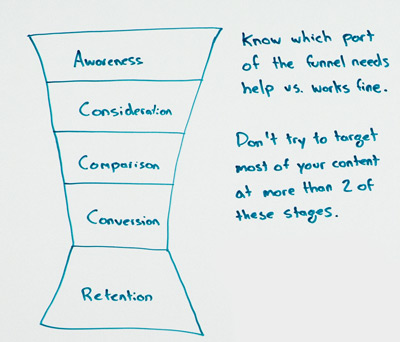How to Create a Winning SaaS Content Strategy – a Nutshell Guide

It’s no longer 2010. Traditional marketing doesn’t cut it anymore. Everybody’s trying to sell you something. Billboards, TV, online and radio ads have gotten so ubiquitous that we’ve grown accustomed to ignore them.
That’s where content marketing comes into play.
It’s not a revolutionary technique. In fact, content marketing has been around for quite some time now. But we’ve only begun to get good at leveraging its true power in recent years.
At Idunn, we’ve worked with quite a few SaaS companies. And we’ve almost always had to explain the usefulness of a SaaS content strategy. Most business owners in this field would simply tell us:
“We want to sell. We don’t need a blog or a white paper. We need ads.”
This is partially true. Ads work much faster than content marketing. But this doesn’t mean you don’t need a SaaS content strategy if you plan to stick around for a while.
And here’s why:
Why Do You Need a SaaS Content Strategy?
Before you say you are going to invest your entire budget in Google AdWords, take a look at these arguments and statistics:
- SaaS is a VERY competitive market. And it’ bound to grow even more. Irrespective of the industry you are catering to, you will face fierce competition.
- According to HubSpot, 47% of buyers read between 3 and 5 pieces of content before even talking to a sales rep. If they can’t find content, they’ll move elsewhere.
- Content is the best way to keep your customers engaged. If your SaaS model is based on a monthly fee, you need to make sure that your customers won’t jump ship whenever your competitors offer them a better price. The best way to do that is offer them engaging, informative and relevant content.
- You can get more leads for less. According to Demand Metric, content marketing costs 62% less than traditional marketing and can generate 3 times as many leads.
- 77% of B2C marketers and 86% of B2B marketers already invest heavily in content marketing. Odds are your competition is, too!
- The era of pushy salesmen is over. It is now time for inbound sales aka sales based on content marketing.
Now that you know how a SaaS content strategy can help you, let’s how you can great a good one.
How to Create a Successful SaaS Content Strategy
As all successful endeavors, content marketing also has to start with a strategy. Here’s what you need:
-
Get to Know Your Buyer Persona
This is the cornerstone of any marketing strategy – you need to know exactly whom you’re selling to. And I’m not just talking about generic socio-demographic features.
Go beyond the usual age, job and income stats and dig deeper. Find out what they like to eat, where they go out, what are the main challenges they face at home and in their personal lives and what they like to read (online and offline).
As soon as you have a better understanding of your buyer persona as a professional and as an individual, you will know what topics to tackle and what tone of voice to use, as well as where to promote your content.
Whether your strategy is designed for a B2B or a B2C SaaS, understanding your buyer persona both from a professional and a personal point of view will be of great help. For instance, even if they use Facebook solely for personal purposes, it doesn’t mean that your SaaS’ social media profiles won’t catch their eye if they’re relevant for their professional life.
In fact, selling to the wrong customer can actually cripple your SaaS growth. It may seem like a good idea in the short run (who doesn’t like extra money, right?), but it may be disastrous for your long-term sustainability.
-
Consider the Bigger Picture
Your SaaS content strategy doesn’t exist in a void. It has to match your general marketing strategy and support your business goals.
At all times, ask yourself how your content strategy is going to help you with SaaS lead generation, upselling, brand awareness or any other objective that your business has. Take a look at this excerpt from a Moz Whiteboard video.
 Image via Moz
Image via Moz
Rand Fishkin advises against trying to create content that fits all these phases. In fact, you shouldn’t try to create content for more than two stages at once.
Why?
Because people have different needs in each of them. In the awareness phase, your job is to reassure them that they’re on the right path by choosing a solution like yours. In the comparison phase, you need to show them that you’re better than your competitors. Finally, in the retention phase, you need to keep users engaged with valuable content that addresses their actual needs and that proves to them again that they made the right choice – white papers that speak of your recent improvements are a great idea here.
You can, of course, have the same format for more than one phase, but not the same content.
For instance, during the free trial, you need to work extra hard to convert your leads into paying customers. Typically, email marketing is your best bet here. Showing genuine care and offering to help people with their learning curve can get you new, loyal customers. But this doesn’t mean you shouldn’t also invite them to one of your webinars to show them additional perks they may gain as a full member of your community or blog posts that help them solve problems or inspire them.
In other words, your SaaS content strategy should be created as an integrated part of your SaaS general marketing strategy.
If you already have the latter in place, you can think about the former as a “layer” that you add on top. It needs to be congruent with what you already have figured out.
-
Establish Clear Goals
Yes, your SaaS content strategy should primarily work towards supporting your business goals. But this doesn’t mean you shouldn’t have some KPIs and benchmarks in place for it.
How many leads do you want to obtain through content marketing? How will content help you with client retention? How do you plan to generate brand recognition through content? These are just a few questions to get you started.
Ideally, you should also have an evaluation system in place. Sure, generating website visits is great, but how does this translate into ROI?
I always encourage my clients to look beyond vanity metrics. Just like any other marketing tactic, content should be designed to help you grow your business through client acquisition and boosting your profit.
-
Audit the Content You Already Have
Even if you don’t even have a blog section in place yet, you must already have some content. Presentations (for investors, for instance), slide shows, web content, social media posts – all these are pieces of content that can be assessed and used as a starting base.
Asses which of them work and which don’t. If one pieces stands out, use it as a point of reference in terms of tone of voice, length or information tackled in it.
And don’t be too quick to deem your pieces as obsolete. Content can be repurposed – with new formats you can always attract new audiences.
-
Create a Content Calendar
As soon as you’ve established which formats you are going to use, it’s time to create your calendar. Again, this should be aligned with your sales funnels. For example, you may choose to focus on lead generation for the first quarter and on lead nurturing the second. Better said, you may choose to put in some extra effort for one of these, as they should, of course, happen simultaneously.
I found that breaking the content into quarters is the easiest way to tackle the planning part. However, it will take some trial and error before you reach to the best type of planning for you.
It’s also a good idea to add the “big themes” in your content calendar instead of titles and keywords that are set in stone.
Why?
Because a lot can change in your SaaS content strategy within a year and even within a month. Your competitors may create a piece with the same title you did and you don’t want to look like a copycat. Even more, in terms of SEO, things change from one day to another. You can do your keyword research ahead of time, but be sure to repeat it before you sit down to write. You may find that it has become harder (or easier, although that rarely happens) to rank for a certain keyword in the meantime.
-
Identify the Best Channels to Promote Your Content
There is no SaaS content strategy without a strong distribution plan. From social media channels to syndication and email campaigns, the digital world is your oyster.
I usually recommend the 80-20 formula here. Spend 20% of your time creating content and 80% of it promoting or distributing it. Yes, it makes sense to tweet your blogs more than once, just as it makes sense to use more than one channel for one piece of content.
Revert back to your buyer persona. Where do they like to hang out online? This is where your content needs to be! Also, make sure that you keep the purchase phases in mind. There is no reason to include a lead generation piece of content in the newsletter you send to existing customers.
-
Analyze, Measure and Tweak
This is about more than accountability – although this is very important, too. Measure how your content marketing did compared to that of your competitors and, most importantly, if it reached its goals and helped with those of your business.
There is no one recipe for success here, so you will most likely have to tweak your strategy for the next quarter or next year. Be ruthless: if something didn’t work, there’s no reason to keep at it adamantly.
Need help with your SaaS content strategy? We can help! Get in touch with our skilled content marketers now:


2 Comentarii la “How to Create a Winning SaaS Content Strategy – a Nutshell Guide”
[…] is that you have to have a reason. Otherwise, your blogging won’t fit with the rest of your content strategy or marketing strategy and it will be all for […]
[…] content strategy is the cornerstone of SEO […]